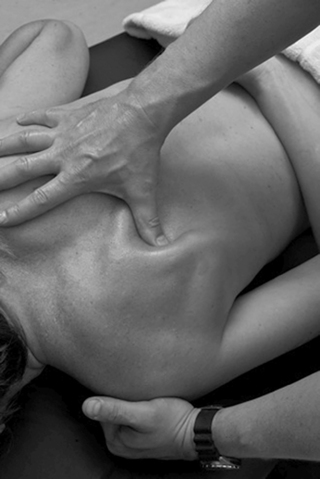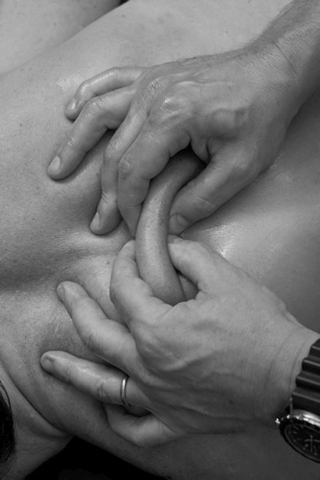7.2 Trigger point therapy Trigger point therapy has been practiced for several centuries, but it did not really enter into the realm of clinicians and researchers until Travell identified typical referred pain patterns associated with trigger points, developed a structured approach for their management, and conceptualized myofascial pain as a separate diagnosis. A trigger point is defined as ‘a hyperirritable spot in skeletal muscle that is associated with a hypersensitive palpable nodule in a taut band’ (Simons et al. 1999). By definition, trigger points are located within a taut band of contractured muscle fibers and palpating for trigger points starts with identifying this taut band by palpating perpendicular to the fiber direction. Usually, trigger points develop as a result of local muscle overuse and are frequently associated with other dysfunctions, such as pain diagnoses with peripheral and central sensitization, joint dysfunction, dental or otolaryngic diagnoses, visceral and pelvic diseases and dysfunctions, tension-type headaches and migraines, hypothyroidism, systemic lupus erythematosus, infectious diseases, parasitic diseases, systemic side effects of medications, and metabolic or nutritional deficiencies or insufficiencies. Trigger points have been reported in all age groups, except infants (Dommerholt et al. 2006a). Any therapeutic intervention should be evidence-informed and based on scientific evidence, clinicians’ judgments, expertise, and clinical decision making. The current thinking about trigger points is best captured by the evidence-informed integrated trigger point hypothesis (Stecco et al. 2009). Although the model is not a perfect theoretical concept, the hypothesis along with several recent modifications is the most comprehensive framework currently available to explain the role of muscle tissue in acute and more persistent pain conditions, and to guide therapeutic management (Gerwin et al. 2004, McPartland, 2004, Dommerholt et al. 2006a, McPartland and Simons, 2006). Trigger points are associated with dysfunctional motor endplates with an excess release of acetylcholine attributed to a variety of possible reasons, including an insufficiency of acetylcholinesterase, an increased sensitivity of the nicotinic acetylcholine receptors, an acidic pH, hypoxia, a lack of adenosine triphosphate, certain genetic mutations, certain drugs and particular chemicals, such as calcitonin gene-related peptide, di-isopropylfluorophosphate, or organophosphate pesticides (Gröbli & Dommerholt 1997; Müller & Stratz 2004). Numerous studies have supported the hypothesis in rabbit, human and equine models (for example Dommerholt et al. 2006a). Physicians, physical therapists, chiropractors, bodyworkers, and other clinicians should work to decrease trigger point pain and reverse the observed hypoxia and low pH by releasing trigger points and normalizing tissue extensibility. Therapeutic interventions may include manual and modality-based approaches and techniques. Different compression techniques appear to have similar efficacy (Fernández-De-Las-Peñas et al. 2005; Gemmell et al. 2008). Trigger points can also be treated with invasive techniques, such as trigger point dry needling or injections with anesthetics, botulinum toxin, or serotonin antagonists (Dommerholt et al. 2006b). Noninvasive trigger point therapy Two recent review articles explored the efficacy of manual trigger point therapies, which may include ischemic compression, trigger point compression combined with active contractions of the involved muscle, myofascial release techniques, postisometric relaxation, connective tissue and fascial stretches, massage therapy, spray and stretch (Fig. 7.2.1), muscle energy techniques, neuromuscular therapy, other soft tissue mobilization techniques, such as skin rolling (see Figs 7.2.2, 7.2.3) and strain–counter strain, among others (Fernández-De-Las-Peñas et al. 2005; Rickards 2006). It is difficult to evaluate which manual approaches are the most effective, since in reality most clinicians use a multimodal approach (Chaitow & Delany 2003). Nevertheless, several studies demonstrated an increase in pain pressure threshold, a decrease in pain ratings on visual analog scales, or an improvement in objective tests, such as the Oswestry Disability Index. Massage therapy was more effective than spray and stretch in one study, but another study showed that spray and stretch increased the pain pressure threshold and was even more effective when combined with deep pressure massage. Spray and stretch was a hallmark of the approach used by Travell, who learned about the technique from Dr. Hans Kraus. The spray and stretch technique involves a vapo-coolant such as ethylchloride or fluorimethane contacting the skin over the muscle and into the referral zone of a trigger point. The spray is passed along the skin in sweeps several times while the muscle is stretched. This is repeated several times, with increased stretch on the muscle. Apparently, the skin cooling acts as a distraction for the stretch, which seems to facilitate inactivation of trigger points. Unfortunately, fluorimethane has a detrimental effect on the ozone layer and is rarely used anymore. A new ‘spray and stretch’ product was introduced a few years ago, but this product contains hydrofluorocarbons, which are powerful greenhouse gases classified as volatile organic compounds with a carbon dioxide equivalent of 1300, which means that the product has a 1300 times greater greenhouse effect than carbon dioxide (Dommerholt et al. 2006b; Dommerholt and McEvoy, in press). During the 1980s, Swiss physician Dejung developed a comprehensive treatment strategy which combined several muscle and fascia techniques, but the effectiveness of this combination of techniques has not been shown in a double-blind randomized controlled study (Gröbli & Dommerholt 1997). Generally speaking, there is some evidence of the short-term effectiveness of manual therapies, but there are few, if any, studies that demonstrate medium or long-term effectiveness beyond placebo (Rickards 2006). Ultrasound is a commonly used modality in chiropractic and physical therapy even though its efficacy is generally considered to be poor. As a trigger point therapy, ultrasound improved pain intensity, pressure threshold, and cervical range of motion in one study, but failed to have any effect in other studies. Researchers in Turkey recommended using a high-power pain threshold static ultrasound technique with continuous US, ramped gradually to the patient’s maximum pain level, held for 4 to 5 seconds and reduced by 50% for 15 seconds, which resolved active trigger points more rapidly than conventional applications of ultrasound (Majlesi & Unalan 2004). Standard ultrasound applications do have a temporary antinociceptive effect on trigger points, but not sufficient to justify including conventional ultrasound in clinical practice (Dommerholt and McEvoy, in press). Transcutaneous electrical nerve stimulation, or TENS, is the most researched electro-modality in the treatment of trigger points and there is good evidence of its short-term effectiveness. Interestingly, TENS did decrease overall myofascial pain, but did not reduce the actual trigger point sensitivity in several studies (Rickards 2006). There is no scientific evidence of medium or long-term effects of TENS. In a series of low-quality retrospective studies and case reports of frequency-specific electrotherapy in patients with myofascial pain and fibromyalgia, McMakin suggested that this form of electrotherapy is more effective than other electrotherapies, but there is no scientific evidence of the claims, even though in one of the articles she does report having observed a decrease in the concentrations of cytokines following the electrotherapy (McMakin et al. 2005).
Introduction
Principles of trigger point therapy
Trigger point therapy
Manual approaches
Modality-based approaches
![]()
Stay updated, free articles. Join our Telegram channel

Full access? Get Clinical Tree


Trigger point therapy









